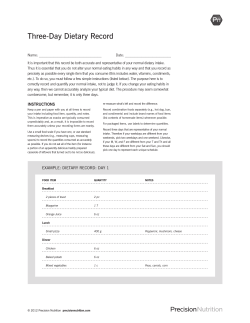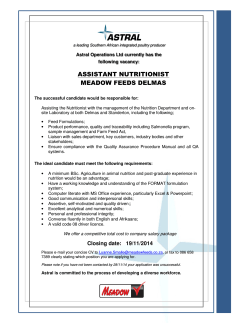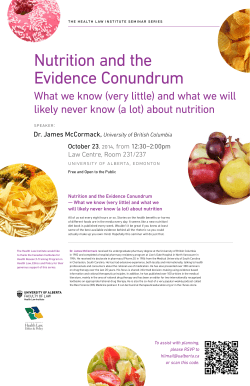
United States Department of Health and Human Services Office of
United States Department of Health and Human Services Office of Disease Prevention and Health Promotion United States Department of Agriculture Center for Nutrition Policy and Promotion Dietary Guidelines Advisory Committee COMMENTS OF: Secretary Dan Glickman Secretary Ann M. Veneman Secretary Mike Leavitt Secretary Donna E. Shalala Bipartisan Policy Center Nutrition and Physical Activity Initiative Lisel Loy Staff Director 1225 I St, NW Suite 1000 Washington, DC 20005 (202) 204-2400 November 6, 2014 Dr. Barbara Millen Chair, 2015 Dietary Guidelines Advisory Committee Office of Disease Prevention and Health Promotion Office of the Assistant Secretary for Health, Office of the Secretary, U.S. Department of Health and Human Services 1101 Wootton Parkway, Suite LL100 Rockville, MD 20852 Re: 2015 US Dietary Guidelines Dear Dr. Millen, The Co-Chairs of the Nutrition and Physical Activity Initiative of the Bipartisan Policy Center (BPC) appreciate the opportunity to provide input to the 2015 Dietary Guidelines Advisory Committee as you develop this important tool to guide healthy eating for Americans. BPC supports the joint USDA and HHS Dietary Guidelines process and urges the continued adherence to the best available evidence to ensure the guidelines most effectively help combat our nation’s obesity crisis. In addition to the process of developing the guidelines, it is also critically important that they are disseminated widely, consistently, and in a way that is targeted to a full range of audiences so that all Americans can make informed choices about what food they buy for themselves and their families. The Nutrition and Physical Activity Initiative that we co-chair was launched with the goals of reducing obesity and chronic disease and their associated health care costs. The impact of our nation’s obesity crisis reaches far and wide, affecting not only the health of individuals and health care spending, but also our economic and national security. In June 2012, we released a series of policy recommendations in our report, Lots to Lose: How America’s Health and Obesity Crisis Affects our Economic Future. Consistent with those recommendations, we offer the following input to the Committee. 1. The 2015 Dietary Guidelines for Americans must adhere to the principles of sound science, backed by adequate new research. The Dietary Guidelines should be rigorously science-based and insulated from political interests. And because nutrition science is evolving every year, updating the Guidelines on a regular basis is important to keeping them scientifically accurate. The Guidelines should be determined in a transparent way, using the latest nutrition science, and maintenance of the Nutrition Evidence Library helps to accomplish these goals. One recommendation in our 2012 report was that Congress provides sustained support for relevant research coming from USDA. Research on nutrients, eating patterns and the dietary implications for health, the impact of food assistance programs, behavioral economics, and interventions related to obesity are all critical areas of study that help inform the fight against obesity. Given the scale of the obesity crisis, nutrition research should receive sustained, adequate funding so that the Dietary Guidelines and other nutrition-related decisions from the federal government can be based on comprehensive, up-to-date information. 2. USDA should ensure all federal feeding programs reflect and support the Dietary Guidelines. The development of the Dietary Guidelines is critically important because they serve as the basis for the nutrition standards in federal feeding programs such as school meals, WIC, and CACFP. Secretaries Glickman and Veneman have articulated the need for sciencebased nutrition standards publicly in the media, most recently in Roll Call regarding the WIC food packages; in 2011 we made a similar statement on school meals standards.1,2 Aligning nutrition standards with the Dietary Guidelines is a critical first step toward ensuring that federal feeding programs are also science-based. Once the 2015 Dietary Guidelines for Americans are published, we urge USDA to assess all federal feeding programs to ensure that they are implemented in accordance with the Guidelines. 3. The federal government must develop and disseminate clear, consistent, user-friendly messaging for all Americans, including those who receive federal food assistance. We hope to see clear and consistent messaging from the 2015 Dietary Guidelines that can help people make better food choices and reduce the public’s confusion over what constitutes a healthy diet. This messaging campaign should be coordinated with the messaging from WIC and other federal nutrition programs; among online platforms such as ChooseMyPlate.gov, HealthFinder.gov, and CDC.gov/HealthyLiving; and user-friendly materials should be disseminated to augment state and community-level efforts to improve nutrition. Aligning messaging campaigns from all governmental sources of health and nutrition information can help raise the prominence of and trust in the Dietary Guidelines by reducing the fractured nature in which people receive nutrition messages. The change from 1 2 http://www.rollcall.com/news/keep_nutrition_science_in_the_wic_program_commentary-233269-1.html http://www.huffingtonpost.com/dan-glickman/to-capitol-hill-end-the-f_b_1111396.html MyPyramid to MyPlate was a vast messaging improvement that occurred after the 2010 guidelines were published and we hope to see USDA and HHS continue to build off this positive change in 2015. Finally, we commend the Committee for agreeing to include specific guidelines for children ages zero to two years as part of the 2020 Dietary Guidelines for Americans. This commitment reflects our report’s recommendation that the Dietary Guidelines be extended to all Americans. Given the growing evidence around the importance of the early establishment of healthy eating patterns, we are pleased to see recognition by the Committee of the importance of guidelines for the first thousand days, covering pregnant and lactating women and children up to age two. Thank you again for the opportunity to provide input during the development of the 2015 Dietary Guidelines. We urge the Committee to give thoughtful consideration to our comments and we welcome the opportunity to discuss any specific questions that the Committee may have. Sincerely, Secretary Dan Glickman, Co-Chair, Nutrition and Physical Activity Initiative, Bipartisan Policy Center and former Secretary of Agriculture Secretary Ann M. Veneman, Co-Chair, Nutrition and Physical Activity Initiative, Bipartisan Policy Center and former Secretary of Agriculture Secretary Mike Leavitt, Co-Chair, Nutrition and Physical Activity Initiative, Bipartisan Policy Center and former Health and Human Services Secretary Secretary Donna E. Shalala, Co-Chair, Nutrition and Physical Activity Initiative, Bipartisan Policy Center and former Health and Human Services Secretary
© Copyright 2025
















